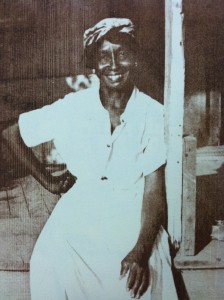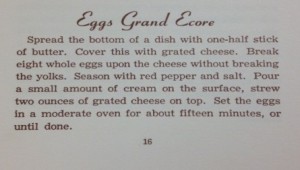By: Allyson Holliday, W.S. Hoole Library Complex Copy-Cataloger
Clementine Hunter was born in 1880 “in the lower reaches of the lush Cane River country” of Louisiana (Introduction, 4-5). She grew up working in the cotton fields and pecan groves of different plantations before moving to Melrose Plantation as a teenager. Melrose was a very large plantation, created by a former slave called Marie Therese and her family in the late 1700s. The plantation had become known as an agricultural empire, with its thousands of acres of corn, cotton, tobacco and hundreds of head of cattle.
The plantation was eventually sold to John Hampton Henry and “Miss Cammie” (Carmelita Garritt Henry) in 1898. Miss Cammie desired to preserve the arts and crafts of the Cane River area, and over the years Melrose became a haven for many artists and writers. Clementine was eventually promoted from the fields to the house. It became clear that she had hidden talents and this is where her culinary and artistic side was allowed to shine.
Clementine became known for her recipes while working in the Melrose kitchen. Boiled Bass, Potatoes Arroyo Hondo, and Game Soup were just a few of the unique recipes she created. As the plantation’s guest book of artists and writers grew, so did the fame of Melrose and its cuisine.
Clementine compiled the Melrose Plantation Cookbook (Lupton TX715.M53 1956) with her friend and artistic mentor, Francois Mignon, in 1956. It consists of 31 of her recipes including this recipe for “Eggs Grand Ecore.”
While known for her delectable cooking in her time, Clementine also began to paint with encouragement from Francis Mignon. Over some 40 years, she produced over 5,000 paintings, each one telling a story of life as she saw it in a simple, straightforward way. She did not always have canvas so she used old window shades, bottles, cardboard or even brown paper bags. She was illiterate, but her paintings were her storybook – a storybook about everyday life on and around the plantation. Her prolific folk art soon led to her being known in some circles as the “Black Grandma Moses.”
Clementine Hunter died on January 1, 1988 and was buried near Melrose Plantation, next to her friend Francois Mignon who believed in her gift.
The Melrose Plantation Cookbook is an excellent example of the library’s holdings in African American history and culture.
Editor’s note: Want to learn more about the David Walker Lupton African American Cookbook collection or view a list of all the books found in the collection? Read about it here.
Intrigued by Clementine Hunter’s art as well as her cooking? Start by reading “Looking for Clementine Hunter’s Louisiana” and then check out Clementine Hunter: Her Life and Her Art by Art Shiver and Tom Whitehead. An excerpt from Shiver and Whitehead’s book can be seen on South Writ Large. You can even keep up with Clementine Hunter’s work as it is covered in social media by liking her fan Facebook page!




One Response to The Culinary Arts of Clementine Hunter, Louisiana’s Black “Grandma Moses”